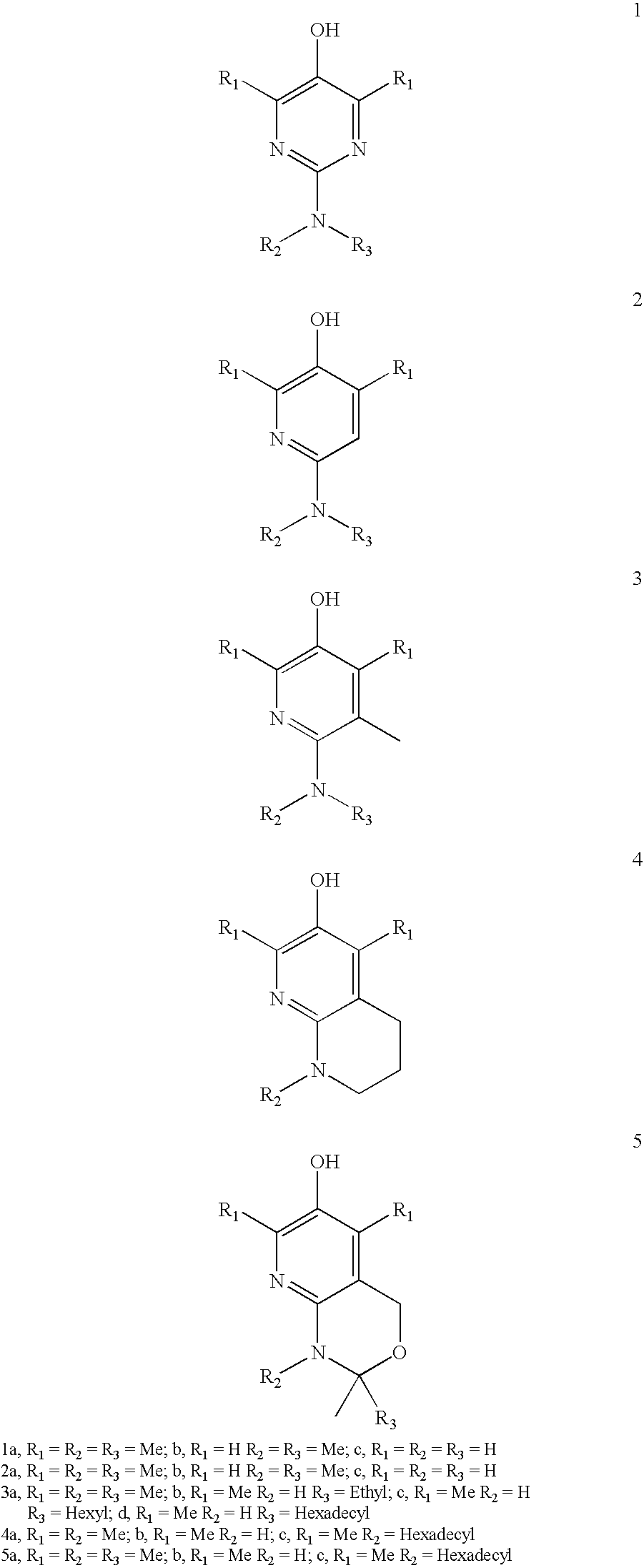Inhibitors of hemeprotein-catalyzed lipid peroxidation
a technology of hemeproteins and inhibitors, which is applied in the direction of heterocyclic compound active ingredients, biocide, drug compositions, etc., can solve the problems of severe side effects, limited therapeutic use of conventional nsaids, and undesirable side effects
- Summary
- Abstract
- Description
- Claims
- Application Information
AI Technical Summary
Benefits of technology
Problems solved by technology
Method used
Image
Examples
example 1
[0090]This example shows inhibition of PGHS-1 by N-dimethyl pyridinol and N-dimethyl pyrimidinol analogues of acetaminophen (ApAP), and includes the following graph. Hematin-reconstituted PGHS-1 5.4 nM in Tris HCl 100 mM, pH 8.0, 500 μM phenol, was pre-incubated with acetaminophen (ApAP), 2-(dimethylamino)pyrimidin-5-ol (DM-Pym) or 6-(dimethylamino)pyridin-3-ol (DM-Pyr) at varying concentrations at 37° C. for 20 minutes. At this time the reaction was initiated by addition of 0.5 μM of [14C] arachidonic acid. After 8 seconds, the reaction was stopped by adding an ice cold mixture of diethyl ether / methanol / 4.0 M citric acid. PGHS-1 activity was expressed as percent oxidation of arachidonic acid compared with control where no inhibitor was added. Each data point represents the mean ±S.E.M of six values.
example 2
[0091]This example shows the effect of ApAP and DM-Pym analog on the initial rate of reduction of ferryl-myoglobin, and includes the following graph. Reduction from ferryl to ferric myoglobin by acetaminophen (ApAP, dashed line) or by 2-(dimethylamino)pyrimidin-5-ol (DM-Pym, plain line) was monitored by recording visible spectra between 350 and 650 nm. Ferryl myoglobin was generated by incubating ferric myoglobin 10 μM in PBS with 10 μM hydrogen peroxide until there was no more change in the peak at 421 nm. At this time, the analogs were added to the cuvette at the final concentrations indicated and spectra were recorded every 15 sec for 2 min. The initial rate of reduction was calculated as the variation of absorbance at 409 nm in the first two minutes after adding the analogs. In this period of time the rates of reduction were linear for each concentration of analog.
example 3
[0092]This example shows the selective inhibition of COX isoforms by acetaminophen analogs. Hematin-reconstituted COX-1 (5.4 nM) or COX-2 (10.8 nM) in Tris HCl 100 mM, pH 8.0, 500 μM phenol, was pre-incubated with N-dimethyl pyrimidinol (DM, plain line) or N-dimethyl pyridinol (DR, dashed line) at varying concentrations at 37° C. for 20 minutes (and includes the following graphs). At this time the reaction was initiated by addition of 0.5 μM of [14C] arachidonic acid. After 8 seconds, the reaction was stopped by adding an ice cold mixture of diethyl ether / methanol / 4.0 M citric acid. PGHS-1 activity was expressed as percent oxidation of arachidonic acid compared with control where no inhibitor was added. Each data point represents the mean ±S.E.M of six values.
PUM
| Property | Measurement | Unit |
|---|---|---|
| pH | aaaaa | aaaaa |
| Oxidative stress | aaaaa | aaaaa |
| swelling | aaaaa | aaaaa |
Abstract
Description
Claims
Application Information
 Login to View More
Login to View More - R&D
- Intellectual Property
- Life Sciences
- Materials
- Tech Scout
- Unparalleled Data Quality
- Higher Quality Content
- 60% Fewer Hallucinations
Browse by: Latest US Patents, China's latest patents, Technical Efficacy Thesaurus, Application Domain, Technology Topic, Popular Technical Reports.
© 2025 PatSnap. All rights reserved.Legal|Privacy policy|Modern Slavery Act Transparency Statement|Sitemap|About US| Contact US: help@patsnap.com



